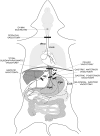Identifying the Source of a Humoral Factor of Remote (Pre)Conditioning Cardioprotection
- PMID: 26918777
- PMCID: PMC4769182
- DOI: 10.1371/journal.pone.0150108
Identifying the Source of a Humoral Factor of Remote (Pre)Conditioning Cardioprotection
Abstract
Signalling pathways underlying the phenomenon of remote ischaemic preconditioning (RPc) cardioprotection are not completely understood. The existing evidence agrees that intact sensory innervation of the remote tissue/organ is required for the release into the systemic circulation of preconditioning factor(s) capable of protecting a transplanted or isolated heart. However, the source and molecular identities of these factors remain unknown. Since the efficacy of RPc cardioprotection is critically dependent upon vagal activity and muscarinic mechanisms, we hypothesized that the humoral RPc factor is produced by the internal organ(s), which receive rich parasympathetic innervation. In a rat model of myocardial ischaemia/reperfusion injury we determined the efficacy of limb RPc in establishing cardioprotection after denervation of various visceral organs by sectioning celiac, hepatic, anterior and posterior gastric branches of the vagus nerve. Electrical stimulation was applied to individually sectioned branches to determine whether enhanced vagal input to a particular target area is sufficient to establish cardioprotection. It was found that RPc cardioprotection is abolished in conditions of either total subdiaphragmatic vagotomy, gastric vagotomy or sectioning of the posterior gastric branch. The efficacy of RPc cardioprotection was preserved when hepatic, celiac or anterior gastric vagal branches were cut. In the absence of remote ischaemia/reperfusion, electrical stimulation of the posterior gastric branch reduced infarct size, mimicking the effect of RPc. These data suggest that the circulating factor (or factors) of RPc are produced and released into the systemic circulation by the visceral organ(s) innervated by the posterior gastric branch of the vagus nerve.
Conflict of interest statement
Figures




References
-
- Gho BC, Schoemaker RG, van den Doel MA, Duncker DJ, Verdouw PD. Myocardial protection by brief ischemia in noncardiac tissue. Circulation. 1996;94:2193–2200. - PubMed
-
- Przyklenk K, Bauer B, Ovize M, Kloner RA, Whittaker P. Regional ischemic ‘preconditioning’ protects remote virgin myocardium from subsequent sustained coronary occlusion. Circulation. 1993;87:893–899. - PubMed
-
- Pickard JM, Bøtker HE, Crimi G, Davidson B, Davidson SM, Dutka D, et al. Remote ischemic conditioning: from experimental observation to clinical application: report from the 8th Biennial Hatter Cardiovascular Institute Workshop. Basic Res Cardiol. 2015;110:453 10.1007/s00395-014-0453-6 - DOI - PMC - PubMed
-
- Liem DA, Verdouw PD, Ploeg H, Kazim S, Duncker DJ. Sites of action of adenosine in interorgan preconditioning of the heart. Am J Physiol Heart Circ Physiol. 2002;283:H29–H37. - PubMed
Publication types
MeSH terms
Substances
Grants and funding
LinkOut - more resources
Full Text Sources
Other Literature Sources

